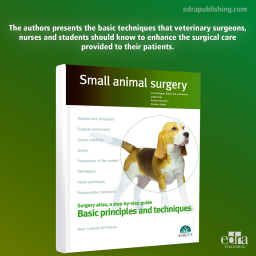





In this book, the authors have tried to show, in a brief and practical manner, the basic principles and techniques that veterinary surgeons, nurses and students should know, master and improve to enhance the surgical care provided to their patients.The book features chapters about the different methods and techniques to control bacterial contamination and surgical infection, both in terms of the fight against microorganisms and the surgeons’ and assistants’ practices in the operating theatre.
In this book, the authors have tried to show, in a brief and practical manner, the basic principles and techniques that veterinary surgeons, nurses and students should know, master and improve to enhance the surgical care provided to their patients. The book features chapters about the different methods and techniques to control bacterial contamination and surgical infection, both in terms of the fight against microorganisms and the surgeons’ and assistants’ practices in the operating theatre. Information about the instruments and suture materials most commonly used in surgery, how they should be handled, and how to use them to cause as little trauma as possible to the patient, is also provided in other chapters. All the content is illustrated by a large number of images to follow the procedures and techniques described step by step. In addition, the e-book includes high-quality and instructive videos to complete the reader’s knowledge of surgery and his/her training.
KEY FEATURES:
➜ Large number of images.
➜ High quality and instructive videos.
Authors
JOSÉ RODRÍGUEZ
Professor of Animal Medicine and Surgery at the Department of Animal Pathology of the University of Zaragoza.
JORGE LLINÁS
Director and surgeon at the Hospital Veterinario Valencia Sur (Valencia, Spain). President of the Spanish Society of Veterinary Laser and Electrosurgery.
ROBERTO BUSSADORI
Director of the Centro Veterinario Criado de Puig (Valencia, Spain).
SALVADOR GUILLÉN
European doctorate in Veterinary Medicine. Cardiovascular, thoracic and airway surgeon at the Clinica Veterinaria Gran Sasso (Milan, Italy).
Table of Contents
1. Surgical conscience and ethics
Introduction
Best results with minimal complications
2. Prevention and control of infection
Nosocomial infections
Blood infections associated with venous catheters
Urinary tract infections associated with urinary catheterization
Surgical site infections
3. Sterilization techniques
Introduction
Steam autoclaves
Sterilization of heat-sensitive material. Chemical sterilization
4. Surgical instruments
Basic concepts
Instrument parts
General categorization of instruments
5. Surgical suite. Cleaning, inspection and maintenance.
Introduction
Characteristics of the surgical suite
Cleaning, inspection and maintenance of surgical instruments
6. Packaging of material for sterilisation
Introduction
Packaging for sterilisation
Sterilisation packages
Packaging technique
7. Suture and ligation materials
General characteristics of surgical thread and needles
Characteristics of suture thread
Classification of sutures
Suture package information
Needles
Types of suture and needle by tissue.
Basic concepts
8. Catheters and drains
Introduction
Aspiration catheters/Drains
9. Admission and preparation of the patient for surgery
Relationships with owners
Shaving and disinfection of the skin
Preoperative cleaning and washing of the patient
Positioning of the patient on the operating table
Preparation of the surgical field
10.Preparation of surgical staff
Introduction
Clothing in the operating theatre
Behavior in the surgical area
11.Surgical team. Standards during surgery
Introduction
Non-sterile or circulating nurse
Sterile nurse
Preparation and organization of instruments
Protection of the patient. Field drapes
Aid and assistance to the surgeon
12.Initial surgical techniques
Introduction
Skin incision
Dissection and section
Haemostasis
Suturing
Haemostasis. Gauze pads. Sponges.
Gauze balls
13.Postoperative period. Care and monitoring
Introduction
Dressings and bandages
Prevention of self-trauma
Identification of complications
Home care
Removal of sutures
14.Basic surgical techniques
Feeding tubes
Midline laparotomy
Orchiectomy
Ovariectomy/Ovariohysterectomy
Data sheet
Specific References